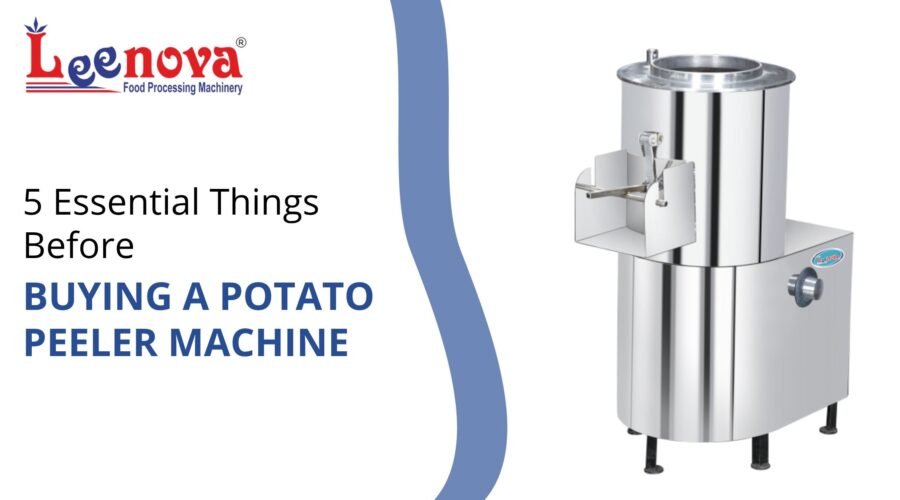Introduction
Most commercial kitchens lose 15-25% of potato volume during manual peeling. Staff spend 90-120 minutes daily on repetitive peeling tasks that slow prep cycles and increase labor costs. Buying the wrong peeler compounds these problems—undersized machines create bottlenecks during peak prep, while oversized units waste power and floor space.
The right potato peeler cuts prep time by 70-80% and reduces peel waste to under 15%. Most buyers focus on drum capacity and miss critical factors like motor duty rating, abrasive drum replacement cycles, and actual throughput during continuous operation. A 20 kg machine doesn’t peel 20 kg per hour—it handles 20 kg per batch with 3-5 minute cycle times.
This guide covers five decision factors that determine long-term performance: capacity matching, build quality standards, motor specifications, peeling efficiency metrics, and maintenance economics. Get these right and the machine pays for itself within 6-8 months through labor savings alone.
Capacity and Throughput Reality
Understanding Batch vs Hourly Ratings
Manufacturers specify batch capacity (10 kg, 20 kg, 50 kg drum size), not hourly output. A 20 kg batch machine requires 3-5 minutes peeling time plus 1-2 minutes loading and unloading. Real-world hourly capacity runs 180-240 kg, not the 400+ kg implied by batch size.
Small operations (50-100 kg daily) need 10 kg batch machines with 0.5 HP motors processing 80-100 kg/hr. Medium kitchens (150-250 kg daily) require 20 kg units with 1.5 HP motors handling 200-240 kg/hr. Large processors (500+ kg daily) need continuous-feed systems rated for 400-500 kg/hr with 3-4 kW motors.
Peak Load Planning
Calculate capacity based on peak prep windows, not daily totals. A hotel processing 200 kg potatoes daily but needing 150 kg prepped before lunch service requires higher throughput than one spreading prep across morning and evening shifts.
Undersized machines force multiple batch cycles that extend prep from 30 minutes to 90+ minutes. Staff idle time waiting for batches negates labor savings.
Build Quality and Material Standards
Stainless Steel Requirements
All food-contact surfaces must use SS 304 grade or higher. Cheaper machines use SS 202 that corrodes from moisture and develops rust spots within 6-12 months. Body construction matters less—mixed builds with SS drums and powder-coated frames cut costs without compromising hygiene.
Drum thickness determines longevity. Quality units use 1.5-2mm SS sheet that withstands daily cleaning and constant tumbling action. Thin construction (under 1mm) dents and warps, causing uneven peeling and premature failure.
Abrasive Drum Surface
Most machines use carborundum (silicon carbide) abrasive linings glued to drum interiors. This abrasive surface removes potato skin through friction as the drum rotates. Lining quality directly impacts peeling efficiency and replacement frequency.
Industrial-grade linings last 8-12 months with proper water flow during operation. Economy versions wear out in 4-6 months and shed abrasive particles into peeled potatoes. Replacement costs run ₹3,000-₹6,000 depending on drum size.
Motor Power and Performance
Horsepower Requirements
Motor power determines drum rotation speed and continuous-duty capability. Half-horsepower motors (10 kg machines) handle 3-4 batches before needing 10-15 minute cooling breaks. This works for low-volume operations doing 2-3 prep sessions daily.
One-point-five HP motors (20 kg machines) run continuously for 90-120 minutes. Most commercial kitchens need this minimum for uninterrupted morning prep. Two HP and higher handle all-day operation in central kitchens and processors.
Single vs Three-Phase Power
Small machines (10-20 kg) use single-phase 220V motors suitable for standard kitchen electrical. Larger units (30+ kg) need three-phase power that requires commercial electrical infrastructure. Verify power availability before ordering—retrofitting three-phase costs ₹15,000-₹25,000.
Single-phase motors above 1.5 HP struggle with startup torque when drums are fully loaded. The machine takes 10-15 seconds reaching full speed, extending cycle times.
Peeling Efficiency and Waste Control
Peel Removal Percentage
Efficient peelers remove 90-95% of skin in one cycle without excessive flesh loss. Research shows optimum peeling occurs at 1440 RPM drum speed with 15-20 second retention time. Slower speeds under-peel, requiring second passes that increase waste. Faster speeds over-peel, removing 20-30% more potato flesh than necessary.
Potato variety affects results. Smooth-skinned varieties peel cleaner with 8-12% total waste. Rough or eyes-heavy potatoes increase waste to 15-20% even with proper machine settings.
Water Flow Integration
Continuous water spray during peeling flushes removed skin from the drum and prevents flesh discoloration. Machines need 8-12 liters per minute flow at 2-3 bar pressure. Inadequate water causes peel buildup that clogs the drum and extends cycle times.
Water consumption matters for operating costs. A 20 kg machine processing 200 kg daily uses roughly 150-180 liters—factor municipal water and sewage charges into cost analysis.
Maintenance Requirements and Economics
Abrasive Lining Replacement
Drum linings wear gradually, reducing peeling efficiency over months. Most operations notice declining performance around 6-8 months. Continuing with worn linings increases cycle times by 40-60% and raises waste percentages.
Replacement requires complete drum removal and professional re-lining. Budget 8-10 hours downtime for the process. Keeping a spare drum assembly eliminates downtime but doubles the lining investment.
Cleaning and Hygiene
Daily cleaning takes 10-15 minutes—rinse drum interior, wipe down exterior, clean discharge chute. Weekly deep cleaning requires removing the drum for thorough scrubbing. Skipping this protocol leads to bacterial buildup and cross-contamination issues.
Machines with easy-access designs simplify cleaning. Top-loading drums with quick-release mechanisms save 20-30 minutes weekly on maintenance tasks.
Spare Parts Availability
Motor bearings, drive belts, and drainage valves require periodic replacement. Machines from established suppliers offer readily available parts and local service networks. Imported or obscure models create supply chain dependencies that extend downtimes from days to weeks.
Additional Considerations
Multi-Vegetable Capability
Most potato peelers handle sweet potatoes, beetroot, carrots, and ginger. This versatility justifies investment by replacing multiple manual processes. Each vegetable type peels differently—carrots need longer cycles, beetroot stains the drum requiring immediate cleaning.
Safety Features
Emergency stop buttons and drum-interlock systems prevent operation when covers are open. These features reduce workplace accidents but add 8-12% to machine cost. Commercial kitchens with high staff turnover benefit from enhanced safety provisions.
Floor Space Requirements
Twenty-kg machines need roughly 3×3 feet floor space plus clearance for loading and discharge collection. Plan for drainage connection—machines sit 6-8 inches from walls for proper plumbing access.
FAQs
What capacity suits a restaurant serving 150-200 meals daily?
A 20 kg batch machine with 1.5 HP motor handles this volume comfortably. Plan for 1 kg potatoes per 8-10 meals served, requiring roughly 150-200 kg weekly. The 20 kg unit completes morning prep in 30-40 minutes with 5-6 batch cycles.
How often do abrasive drums need replacement?
Industrial-quality linings last 8-12 months with daily use and proper water flow. Economy versions wear out in 4-6 months. Replacement costs ₹3,000-₹6,000 depending on drum diameter and lining quality. Watch for increasing cycle times and higher waste percentages as indicators.
Can these machines peel other root vegetables?
Yes—most handle sweet potatoes, carrots, beetroot, ginger, and turnips. Peeling times vary by vegetable hardness. Carrots need 30-40% longer cycles than potatoes. Clean drums thoroughly between beetroot and other vegetables to prevent staining.
Do small machines really save money over manual peeling?
A 10 kg machine costing ₹25,000-₹30,000 replaces 45-60 minutes daily manual labor. At ₹200/hour labor cost, monthly savings reach ₹6,000-₹8,000. Machine pays for itself in 4-5 months excluding waste reduction benefits. Larger operations see faster payback through higher labor displacement.
What maintenance skills do operators need?
Basic cleaning and daily inspection require no special training. Operators learn proper loading, cycle timing, and cleaning procedures in 20-30 minutes. Abrasive lining replacement and motor service need professional technicians. Annual maintenance contracts cost ₹3,000-₹5,000 for preventive service.
Conclusion
Capacity matching, build quality, motor specifications, peeling efficiency, and maintenance economics determine real-world performance. Match machine throughput to peak prep demands, not daily averages. Verify stainless steel grade and abrasive lining quality before purchase.
Calculate total cost including power consumption, water usage, and lining replacement over three years. Factor labor savings and waste reduction into ROI analysis. Most commercial operations recover investment within 6-8 months through productivity gains alone.
Leenova Kitchen Equipments supplies commercial-grade potato peelers engineered for continuous-duty commercial environments. Our specifications team helps calculate actual throughput requirements based on your prep schedule and meal volumes—not generic capacity claims. Visit leenovakitchenequipments.com or contact us for machine sizing and ROI analysis specific to your kitchen operationkitchen operation.


